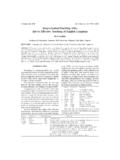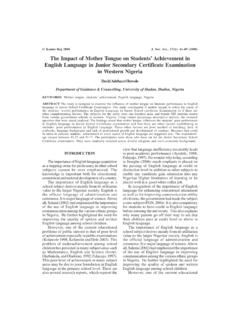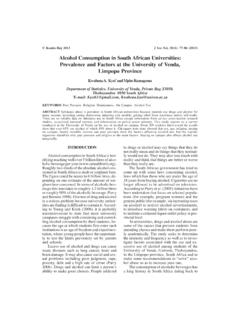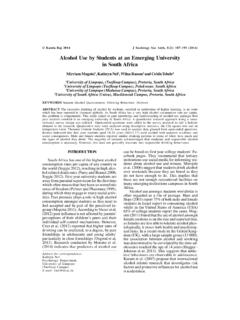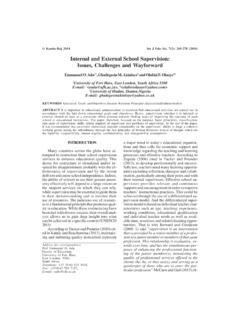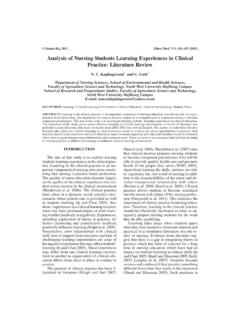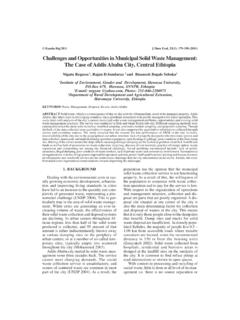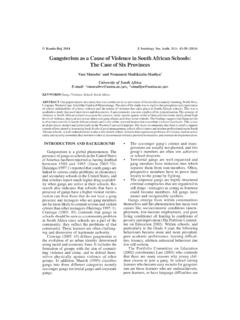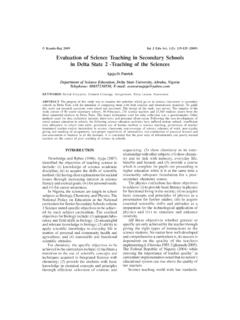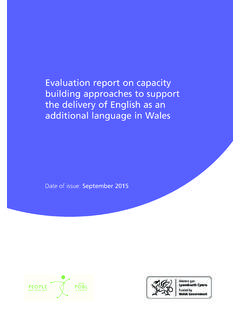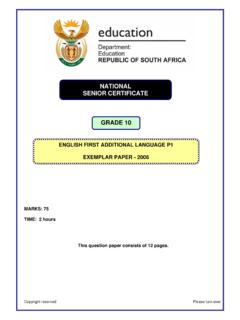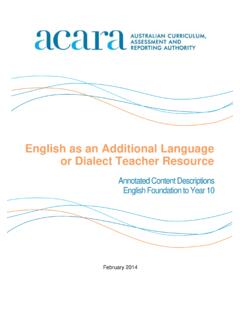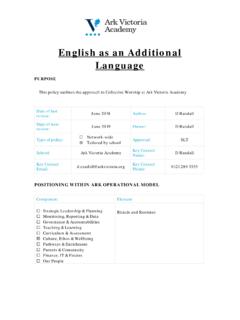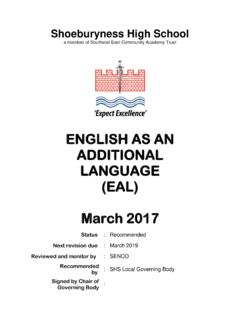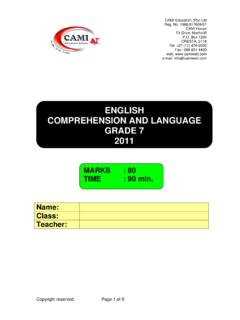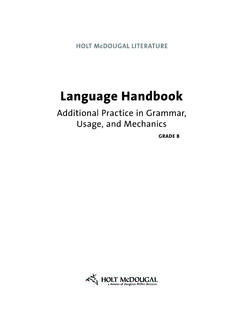Transcription of Home Language versus First Additional Language Instruction ...
1 Kamla-Raj 2014 Int J Edu Sci, 7(3): 647-652 (2014)Home Language versus First Additional Language Instruction :A Comparison of Grade 3 Rural Learners ReadingComprehension in South AfricaMadoda CekisoUniversity of Fort Hare, East London Campus, South AfricaE-mail: Reading Comprehension. Medium of Instruction . Home Language . First Additional LanguageABSTRACT This study seeks to investigate how the Language of learning and teaching (LoLT) affects learners reading comprehension. Two primary schools were chosen, one where the home Language (IsiXhosa) was themedium of Instruction from Grade one to three, with english as a taught subject or First Additional Language andanother school where english ( First Additional Language ) was the medium of Instruction from Grade one, with thehome Language (IsiXhosa) as a taught Language were purposively selected for this study.
2 An english Language readingcomprehension test and IsiXhosa reading comprehension test were administered to 95 Grade 3 learners from thetwo schools. A t-test was used in this study to determine whether the reading comprehension mean scores of the twogroups for both testsdiffered statistically significantly. The results indicated that there was a significant differencein IsiXhosa reading comprehension between learners in the two schools in favour of the learners who were taughtin the mother tongue/ home Language as medium of Instruction . With regard to the english reading comprehensiontest, the results indicated that there was a significant difference in the reading comprehension scores in favour ofthe learners in a school where english was used as medium of Instruction from Grade 1.
3 This study concluded thatlearners perform better in reading comprehension test in the Language that is used as medium of instructionirrespective of whether the Language is a home Language /mother tongue or First Additional Language /second education is the most important lev-el of education because the quality of second-ary and tertiary levels of education is determinedby its quality (Fakeye 2011). In South Africa,there has been a general outcry about the pooracademic performance of learners at all levelswhich are associated with a literacy learning pro-cess in the Foundation Phase (Block 2000). Ac-cording to Adeyemi (2004), most problems man-ifesting at the later stages of education havetheir roots in primary education practices.
4 Theliterature has shown that among the contribut-ing factors to quality education at the primarylevel is the Language that is used as medium ofinstruction (Ball 2011; Heugh et al. 2007; Prin-sloo 2007; Murray 2007; United Nations Educa-tional, Science and Cultural Organization(UNESCO 2007; Susan 2007; Benson 2005;Dutcher 2003; Butzkamm 2003; Block 2000).Murray (2007) states that at many levels the ques-tion of medium of Instruction in education inAfrican countries has become one of the crucialissues in research and discussion at many lev-els. According to Heughet al. (2007), the medi-um of Instruction in primary education is a keyfactor which can both facilitate and optimiseaccess to the content of the curriculum or blocklearning preventing both access and growing body of empirical studies hasshown that using the mother tongue of the learn-ers as medium of Instruction in particular; at theprimary level demonstrate better academic per-formance for learners than those who startschool in second Language (Murray 2007;Heughet al.))
5 2007; Dutcher 2003; Block 2000).UNESCO (2007) emphasises the role of earlychildhood care and development in laying thefoundation for learning and setting the stage forsuccessful engagement in formal education. Itis within this notion that the Department of Ed-ucation in South Africa has placed the issue oflanguage at the forefront of its interventions toimprove teaching and learning. In order to im-prove access to education for all South Afri-cans, the Language in Education Policy (LiEP)which was adopted in 1997 is underpinned bythe principle of maintaining the use of home lan-guage of learners as the Language of learningand teaching. However, the School GoverningBodies in consultation with all the stakeholders(parents, teachers, learners etc.) were allowed tochoose any of the eleven official languages as amedium of CEKISOH owever, there is lack of consensus amongstudies as to the efficacy of the use of homelanguages as medium of Instruction .
6 Althoughsome studies (Murray 2007; Heughet al. 2007)maintain that the use of home languages as me-diums of Instruction produces positive resultsin terms of reading comprehension, others haveshown that using the home Language as mediumof Instruction does not improve the reading com-prehension of the learners (Mgqwashu 2004;Prinsloo 2008, 2009). In addition, Pluddemann(2010) recommends the extension of the use ofmother tongue Instruction in South Africa up toGrade six in order to produce better academicresults. Similarly, UNESCO (2007) argues thatsix to eight years of education in a home lan-guage are necessary to develop the level of lit-eracy and verbal proficiency required for aca-demic achievement in secondary already mentioned above, the literatureindicates that literacy in South Africa is alreadya problem, especially in the Foundation Phase(Grades R to 3).
7 According to Fayeke (2011), Language and education are inseparable becausethe use of Language as a medium of instructionin the teaching/learning situation goes a longway in determining the success achieved by thelearner. It is against this background that thecurrent study seeks to compare the reading com-prehension of learners where the home languageis used as a medium of Instruction with learnerswhere the First Additional Language ( english )is used as a medium of Instruction . Having thisinformation may assist in making a contributionto the current debate about the use of homelanguages as medium of Instruction in the Foun-dation Phase in South Africa and further makeevidence-based recommendations for languageeducation policy. The purpose of this article is,therefore, to address the following questions: Do learners where the home Language isused as medium of Instruction from Grade1 to 3 have significantly higher IsiXhosa(L1) reading comprehension scores atGrade 3 than those in a school where En-glish (L2) is used as medium of instructionfrom Grade 1?
8 Do learners in the school where english (L2) is used as medium of Instruction fromGrade 1 have significantly higher Englishreading comprehension scores at Grade 3than those in the school where the homelanguage is used as medium of Instruction ?Literature ReviewOne of the most important skills learned bythe Foundation Phase learners is the ability tounderstand written text, which is usually referredto as comprehension (Tannenbaumet al. 2006).According to Durkin (1993), reading comprehen-sion is considered the essence of reading. Thus,reading comprehension is one of the pillars ofthe art of reading. In addition, Rice (2007) pointsout that comprehension are regarded as a pro-cess rather than a particular outcome or productthrough which a reader interacts with a text toconstruct meaning.
9 This view of comprehension,according to Rice, emphasises the deliberate,strategic, problem- solving process of the read-er as he engages with a text. The relationshipbetween word knowledge and reading compre-hension has been well documented (Tannen-baum et al. 2006; Scott 2010). Scott (2010) pointsout that vocabulary knowledge is one of thebest predictors of reading comprehension. Hefurther states that among the Foundation Phaselearners, reading comprehension can be predict-ed to a large extent by vocabulary, letter recog-nition and phonemic awareness. According toFielding and Pearson (1994), comprehension isviewed as a much more complex process involv-ing knowledge. Experience, thinking and teach-ing. They further point out that comprehensiondepends heavily on knowledge, both about theworld at large and the worlds of Language idea that primary education is best be-gun in a child s mother tongue has receivedstrongsupport in many education and linguisticcircles (Malone 2007; UNESCO 2007; Benson2004; Butzkamm 2003).
10 Malone (2007) points outthat by the time children begin school they havebegun gaining confidence in their ability to com-municate meaningfully in their home idea and its importance as a resource to beutilized by the Foundation Phase teachers aresupported by many studies (Ball 2011; Fakeye2011; Heugh et al. 2007; Murray 2007; Dutcher2003). It is against this background that theSouth African Constitution guarantees learnersthe right to receive education in the Language oftheir choice (South African Constitution 1996).Influenced by the constitution, the South Afri-can Language in Education Policy recognizesthe benefits to be derived from mother- tongueeducation and commits itself to an additive ap-HOME Language versus First Additional Language INSTRUCTION649proach to bilingualism within the education sys-tem (Prinsloo 2007).
